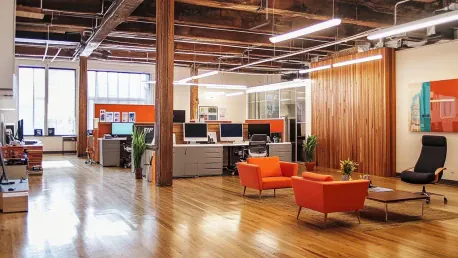As more employees return to full-time in-office work, office design is evolving to meet new expectations. After a period of hybrid and remote work, comfort and flexibility have become key priorities. This article examines the trends that will shape office spaces in 2025, focusing on creating engaging and efficient workplaces.
Vibrant and Dynamic Designs
Bold Color Trends
One noticeable trend is the shift from neutral tones to bold, vibrant colors. Bright hues are being introduced to energize office environments, fostering a lively and inspiring atmosphere. This move away from subdued palettes aims to boost employee motivation and creativity. Designers are now embracing rich colors like teal, mustard yellow, and terracotta to create a dynamic backdrop against which employees can perform their tasks.
This infusion of color serves not only to break the monotony of conventional office designs but also to stimulate visual interest and evoke emotional responses. Research has shown that specific colors can have psychological effects—blue promotes calm and concentration, while red is associated with energy and urgency. By thoughtfully integrating these colors, companies can subtly influence the mood and productivity of their workforce, creating an environment that feels exciting and invigorating.
Invigorating Workspaces
Dynamic designs involving bold color schemes make office spaces more stimulating. Whether through accent walls or colorful furnishings, the goal is to create a visually appealing environment that employees enjoy and feel invigorated in. Importantly, this trend doesn’t merely focus on aesthetic appeal but also considers the functional placement of these colors. For example, having a bright accent wall in a common area can encourage socialization, whereas subtle color cues in work zones can help delineate different functional areas without the need for physical barriers.
The approach to creating invigorating workspaces extends to the materials and textures used, incorporating elements that are both pleasing to the eye and the touch. Sleek finishes, coupled with soft, plush fabrics, can make an office feel both modern and comfortable. In this way, the physical environment itself becomes a tool to heighten engagement and productivity, making employees more inclined to spend time in the office.
Flexible and Multi-use Spaces
Versatile Layouts
Traditional office layouts are giving way to versatile spaces that support various working styles. Offices are now incorporating open collaboration areas, private workspaces, and casual lounge-style seating to accommodate different tasks and preferences. This shift reflects the growing recognition that a one-size-fits-all approach to office design is no longer tenable in a world where employees adopt diverse roles and responsibilities daily.
Furthermore, the use of modular furniture that can be reconfigured quickly allows companies to stay agile and responsive to changing needs. Movable walls and adaptable furniture are becoming staples of modern office design. These flexible layouts serve to empower employees, giving them control over their environment and the freedom to choose settings that optimize their productivity and well-being.
Adaptable Areas
Flexibility extends to seating options, with booths for small meetings, cozy chairs for individual work, and communal tables for teamwork. This variety allows employees to choose work settings that best suit their needs throughout the day. The presence of such adaptable areas also makes it easier to transition between different tasks, from solitary, focused work to collaborative discussions, without the need for employees to move to entirely different locations.
Another significant advantage of adaptable areas is that they can be designed to suit different personality types within the office. For example, introverts might prefer quiet pods or private nooks for deep work, while extroverts might thrive in open areas designed for high interaction. By offering a range of work environments within the same office, companies can cater to the full spectrum of employee preferences, thereby enhancing overall job satisfaction and productivity.
Balance of Style and Functionality
Practical Meeting Zones
Incorporating smaller, informal meeting areas alongside large conference rooms creates a more flexible work environment. These casual zones are perfect for spontaneous discussions and brainstorming sessions. With the increase in impromptu meetings and huddle sessions, the need for versatile and easily accessible meeting areas is more important than ever. These comfortable yet professional spaces are designed to foster creativity and quick thinking, providing the ideal setting for collaborative efforts.
Moreover, integrating technology seamlessly into these practical meeting zones enhances their functionality. Equipped with interactive whiteboards, video conferencing systems, and wireless connectivity, these spaces are designed for modern work dynamics. They allow for quick and efficient sharing of ideas and resources, making it easier to transition between virtual and in-person collaboration effortlessly. This balance of style and functionality ensures that offices not only look good but also work well.
Nature-inspired Elements
Acoustic dividers and partitions, such as green walls, not only define different areas but also bring nature indoors. Including natural elements can enhance both aesthetics and functionality in the workplace. The biophilic design trend, which seeks to connect occupants more closely with nature, is gaining traction as studies continue to show its benefits on mental health and productivity.
Green walls, potted plants, and natural light all contribute to a more relaxed and welcoming atmosphere, reducing stress and increasing overall well-being. These natural elements also serve practical purposes, such as improving air quality and reducing noise levels, creating a more harmonious and serene work environment. By integrating nature-inspired design elements, offices can achieve a perfect blend of style and functionality that benefits employees both mentally and physically.
Cost-Effective Updates
Simple Refreshes
Transforming an office doesn’t always require extensive renovations. Simple updates like adding wallpaper or creating an accent wall can make a significant impact on the office’s look and feel without substantial costs. These minor modifications can quickly modernize a space and infuse it with personality, making it more engaging for employees. Accent walls, adorned with bold colors or unique patterns, serve as focal points that can energize a room and provide visual interest.
Beyond just paint and wallpaper, another cost-effective update is changing the decor. Swapping out old artwork for contemporary pieces or introducing new rugs and cushions can refresh a space without breaking the bank. These minor touches can altogether redefine the atmosphere of the office, making it more inviting and stimulating, which in turn can influence employee morale and productivity.
Enhanced Lighting
Improving lighting by switching to LED fixtures or adding floor and desk lamps can enhance the office atmosphere and reduce eye strain. Maximizing natural light also creates a more welcoming environment. Poor lighting can lead to fatigue, eye strain, and reduced productivity, hence optimizing the lighting conditions is a critical yet often overlooked aspect of office design.
Natural light has been shown to boost mood and energy levels, so designing spaces that make the most of natural light can lead to a happier, more productive workforce. Additionally, the strategic use of artificial lighting—such as task lighting at desks and ambient lighting in common areas—ensures that all areas are appropriately illuminated for their specific use. By investing in better lighting solutions, offices can create a brighter, more vibrant workspace that enhances comfort and efficiency.
Designing for Hybrid Work Habits
Flexible Seating Options
To accommodate hybrid work habits, offices should offer a mix of seating choices, from traditional desks to lounge seating and high-top tables. Such flexibility mirrors the varied work environments employees are accustomed to at home. Employees have become used to moving between different areas for different tasks, whether it’s working at the dining table, couch, or home office. This level of flexibility should extend to the office environment, making it adaptable to whatever work style employees find most productive.
Flexible seating options also encourage mobility and reduce the likelihood of sedentary behavior, which can have numerous health benefits. By providing a range of seating arrangements, employers show they understand and value the need for a versatile workspace that can be customized according to individual needs. This approach ensures that everyone, regardless of their working habits, finds comfort and functionality within the office.
Reservable Workspaces
Hot-desking and reservable workspaces provide the flexibility needed for different work styles and tasks. Private rooms and various seating options allow employees to find the right setting for focused work or collaboration. In a dynamic work environment, having the ability to reserve spaces for specific tasks can significantly enhance productivity and well-being. This system is not only practical but also equitable, ensuring that all employees have access to suitable workspaces as needed.
Reservable workspaces can also help reduce unused space, freeing up valuable real estate for other purposes. This approach aligns well with hybrid work models, where the number of employees in the office may fluctuate throughout the week. By adopting a flexible system, companies can optimize their office layout to accommodate the fluid nature of modern work habits, thereby creating a more efficient and harmonious workplace.
Comfort and Productivity
Ergonomic Furniture
Ergonomic considerations are crucial for a comfortable and productive workspace. Features like sit-stand desks and adjustable chairs can prevent discomfort and help employees maintain focus throughout the day. Proper ergonomics reduce the risk of injury and strain, promoting better posture and overall health. Ergonomically designed workstations can make a significant difference in how employees feel and perform, impacting their long-term well-being and productivity.
Employers are increasingly recognizing the importance of investing in high-quality, ergonomic furniture as a way to demonstrate their commitment to employee health. Adjustable furniture, such as desks that allow for both sitting and standing, enables employees to move freely between postures, reducing fatigue and boosting alertness. This focus on comfort creates a more supportive work environment where employees can thrive.
Acoustic Solutions
In open-plan offices, managing acoustics is key. Soft furnishings, rugs, and acoustic panels help reduce noise, creating a more conducive environment for concentration and productivity. Unlike traditional office spaces, which can sometimes resemble echo chambers, modern designs incorporate materials that absorb sound rather than reflecting it. This approach minimizes distractions and helps maintain a quieter workspace.
Implementing acoustic solutions is particularly important in collaborative settings where multiple conversations can occur simultaneously. From sound-absorbing wall art to specially designed acoustic furniture, there are numerous ways to manage sound levels effectively. These solutions not only improve the acoustic quality but also enhance the overall aesthetic, creating a more pleasant and productive office environment.
Future of Office Design
Inspiring Spaces
As businesses navigate the return to in-person work, the future of office design will focus on creating spaces that inspire productivity and creativity. Offices must go beyond functionality to become places where employees feel motivated and supported. This shift involves integrating elements that foster innovation and a sense of community. By combining vibrant colors, flexible layouts, and nature-inspired designs, modern offices can become hubs of creativity and collaboration.
Moreover, the role of technology in future office design will be pivotal. Seamless integration of advanced technologies—such as smart desks, interactive meeting rooms, and AI-driven workspace management—can further enhance the efficiency and user experience within the office. This convergence of design and technology aims to create a holistic environment that stimulates both the mind and the body, making the office a place employees look forward to spending time in.
Workplace Culture
As more employees return to full-time in-office work, the design of office spaces is evolving to meet their new expectations. After experiencing a period of hybrid and remote work, comfort and flexibility have emerged as critical priorities. This shift is leading to significant changes in how offices are conceptualized and arranged.
In 2025, office spaces will be shaped by trends focused on fostering engaging and efficient workplaces. Companies are looking at ways to create environments that not only support productivity but also enhance employee well-being. This includes incorporating areas for relaxation, collaborative zones, and flexible workstations that can be easily reconfigured to suit different tasks and needs. Additionally, there’s a growing emphasis on using technology to create smart offices that can adapt to varying work styles and preferences.
Overall, the goal is to design office spaces that balance functionality with a welcoming atmosphere, ensuring that employees feel comfortable and motivated while performing their duties.









